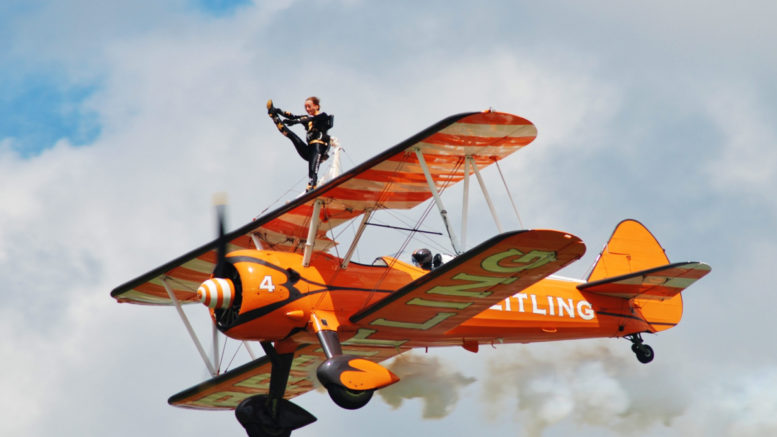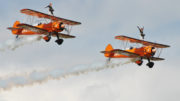We’ve all watched flying stunts on TV or at airshows, and we’ve wondered what it would be like to experience similar exhilarating experiences in the air. Stunt planes are particular aircraft used to perform flying stunts. These planes can reach high speed and thrust levels enough to produce the G-forces required to execute aerobatic maneuvers – like rolls and loops in the air.
Top Safety Precautions and Requirements for Stunt Planes
Stunt planes are one of the main attractions at any good air show performance. Flying stunt planes require great skill and courage, as every stunt has a risk. It is then imperative to properly evaluate these risks and take necessary precautions to mitigate them. Three significant factors need to be considered – the risk involved, the nature of the stunt, and the stunt performer.
Evaluating Risk
Every aerobatic stunt and maneuver has its level of risk and probability of failure, and different factors increase or decrease the risk factor of each stunt. For example, performing rolls become riskier when the weather becomes windy or gusty. Other risk factors must be acknowledged, and steps taken to neutralize or mitigate these risks.
Nature of the Stunt
All stunt planes have peculiar maneuvers, requirements, and difficulty levels. It is essential always to consider the kind of stunt we’ll be performing when planning for safety because the required aircraft specifications to execute a trick ideally would vary. Also, examining the type of maneuvers involved with each action would provide insights into how they could be improved or modified for safer and more effective execution.
Stunt Planes Pilot
As the stunt pilot is in charge of performing the exciting aerobatic maneuvers people pay to experience, they are the most crucial factor to consider when planning for safety in flying stunts. The stunt pilot’s level of experience and qualification should dictate the kind of stunts they are asked to perform. More experienced and qualified pilots should perform the riskier and more difficult stunts.
Safety Precautions for Stunt Plane Participants
If the prospect of participating in stunt planes excites you and you are thinking of booking one anytime soon, the following are necessary precautions you should consider carefully.
Adhere to Standard Safety Rules
The first basic safety guideline is a willingness to adhere to standard safety rules and operate within established safety constraints. People’s search for thrill and the ultimate adventure often relegates standard safety precautions to the backburner.
Most aviation companies that offer stunt flights operate under rules and restrictions, and their required safety equipment and training are allowed before participation in stunt flights. You should always be ready to abide by these standard guidelines and not sacrifice safety on the altar of thrill-seeking.
Consider Your Physical and Health Status
To properly enjoy the stunt experience, you must be in optimal physical and health condition. Thus it is essential to consider the state of your health before signing up for a stunt flight experience. Physical health issues are likely to be aggravated during stunt flights and could even cause medical emergencies, including (but not limited to):
- Motion sickness
- Claustrophobia
- Fear of heights
- Pregnancy
- Neck or back problems
- High blood pressure
It is, therefore, essential to think carefully about your health or consult your general practitioner before booking any stunt experience.
Choose the Right Aviation Company
If you have assessed your health and determined that you are in an optimal physical state, the next thing is to book a stunt flight with a good aviation company. A good number of companies are offering different types of stunt flight experiences. You must carefully assess your options and choose the one that is right for you. Factors to consider before choosing include:
- Cost: Stunt flight prices differ among aviation companies, so choosing the one that best suits your budget is advisable.
- Pre-flight training offerings: It is crucial to get familiar with the different safety equipment and safety guidelines before the actual stunt flight. The pre-flight instruction training covers all you need to know about the aircraft, the safety gear and equipment, and how to communicate effectively with the stunt pilot. Aviation companies offer this pre-flight training with varying quality and detail; go with the company with the most comprehensive pre-flight inspection.
- Reviews and recommendations: It is necessary to consider the reviews and feedback from people who have gone on similar stunt flights with each company to get insight on what to expect when you sign up with them.
Stunt Planes Require Clear Communication
The stunt pilots are professionals who are used to different g-force experiences and are comfortable making all sorts of aerobatic rolls and loops. It would be best if you went into the stunt flight experience informed and confident, knowing what to expect during the flight and how to use the safety equipment properly.
During flights, however, it is essential always to speak up and communicate effectively with the stunt pilot whenever you have any questions or are experiencing discomfort. You should always speak up and communicate with the pilot when you feel uncomfortable or unsafe during any maneuver.
Safety Precautions for Stunt Plane Teams
FAA Regulations for Stunt Planes and Aerobatic Flights
FAA regulations require that no one can operate an aircraft in aerobatic flight:
- Over any congested area of a city, town, or settlement;
- Over an open-air assembly of persons;
- Within the lateral boundaries of the surface areas of Class B, Class C, Class D, or Class E airspace designated for an airport;
- Within four nautical miles of the center line of any Federal airway;
- Below an altitude of 1,500 feet above the surface; or
- When flight visibility is less than three statute miles.
Pre-Flight Prep and PAVE Checklist
The PAVE checklist ensures that everything is functioning optimally before takeoff and with nothing being overlooked.
- P — Pilot-in-Command: The pilot has to be checked to be qualified, experienced, and fully capable of leading all flight operations.
- A — Aircraft: The aircraft is checked and confirmed capable of executing all planned maneuvers and stunts.
- V — Environment: Assess the environment to confirm if weather, temperature, and wind conditions are optimal.
- E — External Pressure: External circumstantial factors influencing the flight are all assessed. Any undue pressure or influence that could hinder the flight is addressed, or the flight is rescheduled.
Key Takeaways About Stunt Planes
Stunt planes can be a very memorable and exhilarating experience. You should, however, not compromise safety in pursuit of this exciting adventure. Adhere to the precautions stated, and not only would you enjoy the flight experience, but there wouldn’t be any harm or injury to taint your memory of the experience.
Ready to Soar with Us?


